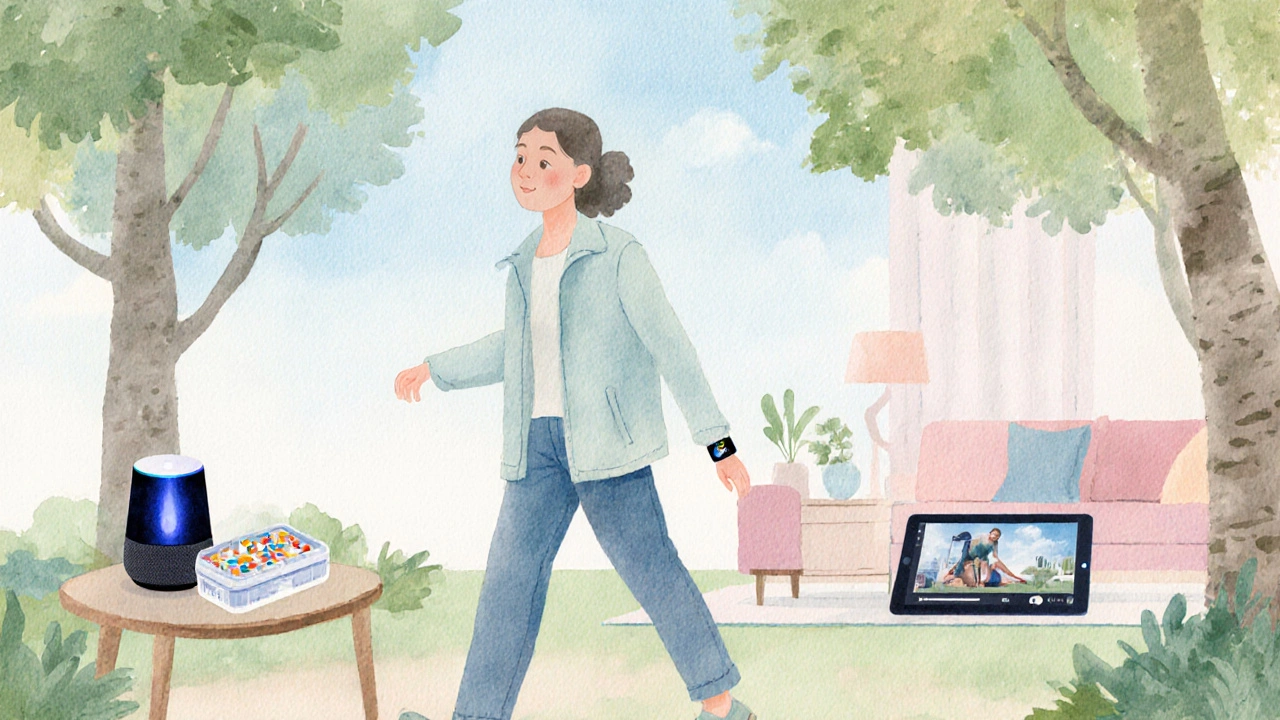
Relationship Strength Builder for Secondary Progressive Disease
Your Personalized Tips
Living with Secondary Progressive Disease is a daily marathon of medical appointments, symptom swings, and emotional roller‑coasters. It’s not just the person diagnosed who feels the strain; partners, family members, and friends often wonder how to stay close when fatigue, mood changes, and physical limitations become the norm. The good news? Strong relationships are possible, and they actually help manage symptoms. Below you’ll find real‑world tips that turn challenges into chances to deepen trust, keep communication clear, and protect both mental and physical health.
Key Takeaways
- Open, consistent communication creates a safety net for both partners.
- Prioritising self‑care for caregivers prevents burnout and improves support.
- Adaptive technology and simple physical activities can maintain intimacy.
- Professional mental‑health resources and support groups are essential allies.
- Regular check‑ins on medication and symptom tracking keep the partnership balanced.
Understanding the Landscape
When people hear the term Secondary Progressive Disease, they often think of Multiple Sclerosis (MS) because it’s the most common condition in this category. In MS, the disease progresses after an initial relapsing‑remitting phase, leading to steady worsening of disability. The key takeaway is that the disease trajectory is not linear-there are good days, bad days, and everything in between. This unpredictability can stress relationships, making clear expectations and flexible plans vital.
1. Build a Communication Blueprint
Communication is the glue that holds any partnership together, especially when chronic illness throws curveballs. Here’s a simple framework:
- Schedule a weekly check‑in. Set aside 15‑30 minutes-no phones, no distractions-to discuss symptoms, emotions, and practical needs.
- Use ‘I’ statements. Instead of “You never help,” try “I feel overwhelmed when I have to manage medication alone.” This reduces blame and opens dialogue.
- Validate emotions. Acknowledge feelings even if you don’t fully understand them. “I hear that you’re frustrated; that sounds exhausting.”
Research from the University of California, San Francisco shows that couples who practice structured communication report 30% higher relationship satisfaction during chronic illness phases.
2. Caregiver Self‑Care is Non‑Negotiable
The person caring for a loved one with a secondary progressive condition often becomes the ‘default’ health manager. Over time, this role can lead to burnout, resentment, and even physical illness. Treat self‑care as a medical prescription:
- Set personal boundaries. Define what tasks you can realistically handle each day and communicate limits clearly.
- Schedule regular wellness activities. Even a 10‑minute walk, meditation, or a hobby can reset stress levels.
- Seek respite support. Home‑care agencies, community volunteers, or trusted family members can provide short breaks.
According to a 2023 study in the Journal of Pain and Symptom Management, caregivers who took at least one hour per week for personal leisure reported 22% lower anxiety scores.

3. Leverage Adaptive Technology
Modern gadgets make daily life smoother for both partners. Here are three tools that can shave minutes off routine tasks:
| Tool | Primary Function | Benefit for Relationship |
|---|---|---|
| Voice‑Activated Assistants (e.g., Alexa, Google Home) | Hands‑free reminders, medication timers | Reduces forget‑fulness, frees mental space for conversation |
| Smart Pill Boxes | Automated dispensing, dosage tracking | Minimises argument over missed doses |
| Remote Physical‑Therapy Apps | Guided exercises via video | Allows joint low‑impact workouts from home |
When both partners understand and use the same tech, the daily grind feels like a team sport rather than a solo challenge.
4. Keep Physical Intimacy Alive
Physical closeness isn’t just about sex; it’s about touch, eye contact, and shared activity. Progressive disease can limit mobility, but intimacy can adapt:
- Modify positions. Pillows, recliners, or sit‑to‑stand lifts can make affectionate moments comfortable.
- Explore low‑impact activities. Gentle yoga, seated Tai Chi, or hand‑holding stretches keep bodies connected.
- Prioritise non‑sexual touch. A daily 5‑minute hand massage or a shared warm shower signals care without pressure.
Data from the National Multiple Sclerosis Society indicates that couples who maintain regular physical affection report 15% better mood scores.
5. Navigate Emotional Ups and Downs Together
Secondary progressive conditions often trigger mood swings, anxiety, and depression. Here’s a joint‑action plan:
- Identify early warning signs. Fatigue, irritability, or sleep disruption can hint at a mental‑health dip.
- Create a crisis kit. Include coping cards (e.g., deep‑breathing steps), emergency contact numbers, and a list of soothing activities.
- Engage professional help early. Psychologists who specialise in chronic illness can teach cognitive‑behavioral strategies that benefit both partners.
According to a 2022 meta‑analysis in Psychology & Health, couples who receive joint counseling see a 40% reduction in relationship strain over two years.
6. Join a Support Group-Together
Isolation is a silent predator. Whether it’s an online forum or a local meetup, sharing experiences builds resilience. Look for groups that welcome both the person with the disease and their partner. Many MS societies run “Couples’ Corner” sessions focused on communication techniques and shared coping.
Being part of a community also provides practical tips-like who in the group can recommend a reliable home‑care aide or which adaptive kitchen tools work best.

7. Track Medications and Symptoms as a Team
Medication schedules can become labyrinthine. Use a shared digital log (Google Sheets, a dedicated app) where both partners can add:
- Drug name, dosage, timing
- Side‑effects observed
- Symptom severity (scale 1‑10)
Seeing trends together helps you decide when to call a neurologist, and it also removes the “who’s responsible?” tension. A 2021 study in Clinical Neurology found that couples who co‑managed medication were 25% more adherent to treatment plans.
8. Celebrate Small Wins
Progressive disease can feel like a series of setbacks, but celebrating even minor achievements fuels motivation. Whether it’s completing a short walk, remembering a medication dose, or simply sharing a laugh, make it a ritual:
- Mark the calendar with a “Victory” sticker.
- Share a favorite treat after a successful week.
- Write a brief note of appreciation and exchange it.
These positive reinforcements strengthen emotional bonds and remind you both why the effort matters.
Putting It All Together: A Sample Week
Here’s a practical snapshot of how the tips can fit into a typical week:
- Monday: 15‑minute communication check‑in; update medication log.
- Tuesday: Joint yoga session using a remote‑therapy app; caregiver takes a 30‑minute walk alone.
- Wednesday: Attend a local support‑group meeting (couples’ session).
- Thursday: Review symptom trends; schedule doctor’s appointment if needed.
- Friday: Celebrate a week of medication adherence with a favorite dessert.
- Saturday: Evening of non‑sexual touch - hand massage and movie.
- Sunday: Rest day; both practice personal self‑care activities.
Adjust the schedule to fit your energy levels, but keep the core pillars-communication, self‑care, technology, and celebration-consistent.
Frequently Asked Questions
Frequently Asked Questions
How often should we have relationship check‑ins?
A brief 15‑minute session once a week works for most couples. If symptoms flare up, add a quick daily touch‑base of 5 minutes.
What if my partner refuses to join a support group?
Start with an online forum where anonymity feels safer. Share positive feedback you hear from others; sometimes curiosity grows after seeing real benefits.
Can adaptive technology replace human interaction?
No. Tech handles reminders and logistics, but emotional connection still comes from conversation, touch, and shared experiences.
What are the signs of caregiver burnout?
Constant fatigue, irritability, loss of interest in previously enjoyable activities, and physical symptoms like headaches are red flags. Seek respite care early.
How can we keep intimacy alive if mobility is limited?
Focus on non‑sexual touch, use supportive cushions for comfortable positioning, and explore activities like seated massage or shared breathing exercises.






Shaquel Jackson
October 9, 2025 AT 13:51Another day, another reminder that life loves to throw curveballs at us 😒.
Tom Bon
October 10, 2025 AT 03:45Thank you for compiling such a thorough guide. The structured communication blueprint and adaptive technology suggestions are especially valuable for couples navigating secondary progressive disease. Your emphasis on mutual self‑care underscores the importance of sustainability in caregiving.
Clara Walker
October 10, 2025 AT 20:25As someone who has closely followed the medical‑industrial complex, it is clear that the narrative presented in many health‑care articles is deliberately crafted to keep patients dependent.
The so‑called “personalized tips” are in fact a Trojan horse for data mining, feeding big‑tech corporations with intimate health metrics.
Every recommendation to use voice‑activated assistants or smart pill boxes subtly pushes the agenda of surveillance capitalism.
Moreover, the emphasis on weekly communication check‑ins masks the reality that many couples are being coerced into constant emotional labor.
The hidden cost is that caregivers are forced into a regime of self‑monitoring that mirrors the control tactics employed by authoritarian regimes.
The article’s reference to “joint counseling” conveniently ignores the fact that licensed professionals are often paid by insurance companies whose profit motives conflict with patient autonomy.
In addition, the claim that “celebrating small wins” improves mood is a simplistic reductionist view that neglects the systemic stressors imposed by pharmaceutical lobbying.
It is also worth noting that adaptive technology devices are seldom tested for accessibility by independent consumer advocacy groups, leading to a false sense of empowerment.
The suggestion to join support groups, while well‑meaning, frequently funnels participants into echo chambers where dissenting opinions about treatment protocols are censored.
Readers should be wary of the language that normalizes chronic illness as an inevitable personal failure rather than a societal health crisis.
The article’s data points are cherry‑picked from studies that are often funded by pharmaceutical giants with vested interests.
By promoting a one‑size‑fits‑all “relationship strength builder,” the author contributes to a commodification of intimacy that benefits tech startups more than patients.
Furthermore, the reliance on digital logs for medication tracking opens up avenues for cyber‑attacks that could compromise sensitive medical records.
The narrative also underplays the psychological toll of constant digital surveillance on both partners.
Ultimately, the piece serves as a veiled advertisement for a suite of products that capitalize on vulnerability.
Readers would do well to critically evaluate each recommendation and seek truly independent sources before integrating these tools into their lives.
Jana Winter
October 11, 2025 AT 15:51While the article offers valuable insights, there are several grammatical inaccuracies that merit correction. The phrase “...the disease trajectory is not linear‑there are good days...” should include a space after the hyphen, and “its” must replace “it’s” when indicating possession. Additionally, consistent use of the Oxford comma would improve readability.
Linda Lavender
October 12, 2025 AT 11:18One cannot help but marvel at the lyrical grandeur with which the author paints the daily odyssey of those living with progressive disease; each bullet point reads like an excerpt from an epic poem, replete with heroic metaphors and lofty aspirations. Yet, beneath the opulent veneer lies a pragmatic checklist that any seasoned caregiver could have assembled in a single afternoon, rendering the prose more decorative than directive. The flowery diction, while evocative, at times obscures the concrete actions that a weary partner desperately seeks. Still, the insistence on celebrating “small victories” feels almost theatrical, as if each triumph were to be staged upon a gilded altar of optimism. In the end, the piece oscillates between a tender love letter and a glossy brochure, leaving the reader to navigate between sincerity and spectacle.
Jay Ram
October 13, 2025 AT 06:45Great reminder about self‑care! Remember to schedule a quick walk or a few minutes of deep breathing each day-small steps keep burnout at bay.
Elizabeth Nicole
October 14, 2025 AT 02:11I love how the guide blends practical tools with emotional encouragement. Trying out a shared calendar for medication tracking has already made our evenings feel less chaotic. Let’s keep experimenting with low‑impact activities together; even a 5‑minute hand massage can spark a smile. Your optimism feels contagious, and it motivates me to stay proactive.
Dany Devos
October 14, 2025 AT 21:38While the preceding analysis raises intriguing concerns about data privacy, it is essential to ground such assertions in verifiable evidence rather than conjecture. The majority of voice‑assistant platforms now offer robust encryption and user‑controlled data deletion options, which mitigate many of the alleged surveillance risks. Moreover, the emphasis on “joint counseling” aligns with best‑practice guidelines from recognized medical societies, suggesting that this recommendation is not merely a profit‑driven agenda.
Sam Matache
October 15, 2025 AT 17:05Reading the poetic flourish of the previous comment feels like watching a theatrical performance where the drama outweighs the substance. The embellished language, though entertaining, does little to advance actionable advice for caregivers who are exhausted by daily routines. A more balanced tone would better serve those seeking concrete, immediate support.
Hardy D6000
October 16, 2025 AT 12:31It’s clear that the push for tech‑driven solutions is nothing more than a façade designed to funnel public funds into corporations that thrive on surveillance, all while the real issue-government neglect of chronic disease research-remains unaddressed.
Amelia Liani
October 17, 2025 AT 07:58I hear the frustration behind those words, and I want to acknowledge how overwhelming it can feel when systemic obstacles seem insurmountable. Please remember that your shared resilience, even in small moments, creates a foundation of hope for both of you. If you ever need a listening ear or a gentle reminder to pause and breathe, I’m here.
shikha chandel
October 18, 2025 AT 03:25They’re hiding the truth about how those “smart” devices manipulate us.